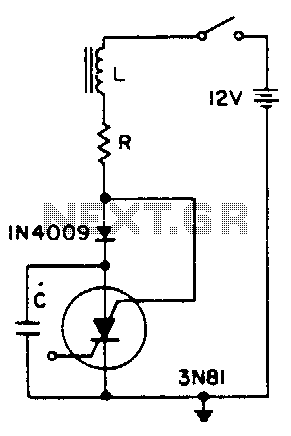
Rlc-oscillator

A positive transient, such as the power switch closing, charges through L to a voltage above the supply voltage, if Q is sufficient. When the current reverses, the diode blocks and triggers the SCS. As the capacitor discharges, the anode gate approaches ground potential, depriving the anode of holding current. This turns off the SCS, and C charges to repeat the cycle.
In this circuit operation, a positive transient occurs when the power switch is activated, leading to the charging of an inductor (L) through a resistor (r). This charging process causes the voltage across the inductor to rise above the supply voltage, contingent on the sufficient quality factor (Q) of the system. As the current through the inductor reverses, a diode is configured to block this reverse current, which consequently triggers a Silicon Controlled Switch (SCS).
The SCS is a semiconductor device that can be turned on by a gate signal and is designed to remain on until the current flowing through it drops below a certain threshold. As the capacitor (C) discharges, the voltage at the anode gate of the SCS decreases, approaching ground potential. This reduction in voltage at the anode gate results in the deprivation of holding current necessary to keep the SCS in the on state.
Once the SCS turns off, the capacitor begins to charge again, preparing the circuit to repeat the cycle. This repetitive charging and discharging mechanism enables the circuit to maintain a continuous operation, effectively managing energy transfer within the system. The described operation is essential in applications such as power supply regulation, energy storage systems, and various switching applications where controlled timing and energy management are crucial.A positive transient, such as the power switch closing, charges r through L to a voltage above the supply voltage, if Q is sufficient. When the current reverses, the diode blocks and triggers the SCS. As the capacitor discharges, the anode gate approaches ground potential, depriving the anode of holding current.
This turns off the SCS, and C charges to repeat the cycle.
In this circuit operation, a positive transient occurs when the power switch is activated, leading to the charging of an inductor (L) through a resistor (r). This charging process causes the voltage across the inductor to rise above the supply voltage, contingent on the sufficient quality factor (Q) of the system. As the current through the inductor reverses, a diode is configured to block this reverse current, which consequently triggers a Silicon Controlled Switch (SCS).
The SCS is a semiconductor device that can be turned on by a gate signal and is designed to remain on until the current flowing through it drops below a certain threshold. As the capacitor (C) discharges, the voltage at the anode gate of the SCS decreases, approaching ground potential. This reduction in voltage at the anode gate results in the deprivation of holding current necessary to keep the SCS in the on state.
Once the SCS turns off, the capacitor begins to charge again, preparing the circuit to repeat the cycle. This repetitive charging and discharging mechanism enables the circuit to maintain a continuous operation, effectively managing energy transfer within the system. The described operation is essential in applications such as power supply regulation, energy storage systems, and various switching applications where controlled timing and energy management are crucial.A positive transient, such as the power switch closing, charges r through L to a voltage above the supply voltage, if Q is sufficient. When the current reverses, the diode blocks and triggers the SCS. As the capacitor discharges, the anode gate approaches ground potential, depriving the anode of holding current.
This turns off the SCS, and C charges to repeat the cycle.